

Questions raised by autonomus cars :
- security / hacking
- Privacy : tracking and using geolocation data
- Automated decision making : liability and insurance
- Moral and ethics
- improvements
- loss of jobs. EU: EDPB issues draft guidelines on connected vehicles. Vehicles are collecting and processing increasing quantities of information.
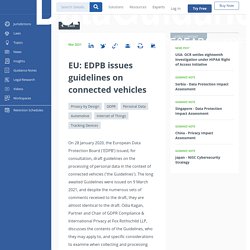
Some even say that you are no longer driving a car, you are actually driving a computer. While a lot of the information is just about the performance of the vehicle, some of it can be used to identify the individuals using the vehicle and will thus constitute 'personal data' under the General Data Protection Regulation (Regulation (EU) 2016/679) ('GDPR').
The EDPB stated that, 'the challenge is for each stakeholder to incorporate the 'protection of personal data' dimension from the product design phase, and to ensure that car users enjoy transparency and control in relation to their data.' But, how is this done in practice? Below is a breakdown of the key points discussed in the guidelines. To whom does this apply? What data? The Guidelines deal with personal data processing in relation to the non-professional use of connected vehicles by drivers, passengers, vehicle owners and other road users. Which stakeholders?
Autonomous cars ethics, security and law. Driveless cars on UK roads. Driveless cars regulated in France. Germany Ethical guidelines. UK Driveless cars Code of Conduct. US Department of transport Guidance. Driveless cars and ethics. Privacy - autonomous cars. Driveless Cars Security and Hacking. Accidents with Driveless scars. Driveless cars improving roads traffic.
Google Driveless car. Google suit against Uber. Uber autonomous cars. Toyota. TESLA CARS. FORD. 25 Corporations Not Named Google Working On Autonomous Vehicles. Google and Tesla might be the biggest names chasing self-driving cars, but a host of auto brands and other tech heavyweights are also investing heavily in driverless R&D. Want to receive a weekly deep dive into all things auto, transportation, & logistics? Click here to subscribe to our new auto tech newsletter. Autonomous Vehicle Technology: A Guide for Policymakers. For the past hundred years, innovation within the automotive sector has created safer, cleaner, and more affordable vehicles, but progress has been incremental.
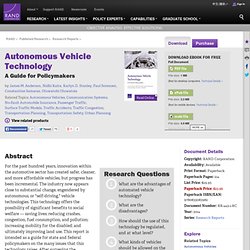
The industry now appears close to substantial change, engendered by autonomous, or "self-driving," vehicle technologies. This technology offers the possibility of significant benefits to social welfare — saving lives; reducing crashes, congestion, fuel consumption, and pollution; increasing mobility for the disabled; and ultimately improving land use. This report is intended as a guide for state and federal policymakers on the many issues that this technology raises. After surveying the advantages and disadvantages of the technology, RAND researchers determined that the benefits of the technology likely outweigh the disadvantages.
However, many of the benefits will accrue to parties other than the technology's purchasers. Autonomous-vehicles-the-public-policy-imperatives. It is 2025 and autonomous vehicles (AVs) are a fact of life.

Many drivers are still behind the wheel of their “classic cars” but the switch rate to autonomous is much faster than predicted. Indeed those still driving are feeling embarrassed by their choice, because society is increasingly intolerant of any road accident, particularly those involving injury or fatality1. Personal mobility has soared in the AV world, with the young, old and disabled rapidly taking advantage of their new freedom2 and working on the move has become second nature. The country is experiencing an economic boom from the resulting rise in productivity3, polls show social happiness has increased from the advent of what is widely known as “stress-free AV”, and there has been a small but noticeable improvement in public health, reducing strain on healthcare services.
This is not a controversial scenario to propose. In any event it is pointless debating the merits of AVs, because they will happen. Governor Cuomo Announces Autonomous Vehicle Testing to Begin in New York State. Governor Andrew M.

Cuomo today announced that New York is now accepting applications from companies interested in testing or demonstrating autonomous vehicles on public roads. Included in the FY 2018 Budget, new legislation allows for testing autonomous technology through a year-long pilot program. In addition to the legislation, the new Department of Motor Vehicles application process is another step forward in making New York the epicenter of cutting-edge technology and innovation. How a College Kid Made His Honda Civic Self-Driving for $700. Brevan Jorgenson’s grandma kept her cool when he took her for a nighttime spin in the Honda Civic he’s modified to drive itself on the highway.
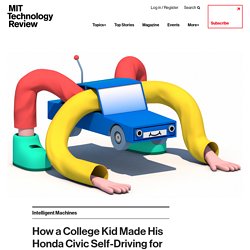
A homemade device in place of the rear-view mirror can control the brakes, accelerator, and steering, and it uses a camera to identify road markings and other cars. “She wasn’t really flabbergasted—I think because she’s seen so much from technology by now,” says Jorgenson, a senior at the University of Nebraska, Omaha. Others are more wary of the system, which he built using plans and software downloaded from the Internet, plus about $700 in parts. Jorgenson says the fact that he closely supervises his homebrew autopilot hasn’t convinced his girlfriend to trust the gadget’s driving. “She’s worried it’s going to crash the car,” he says. Sponsor Content: The Connected Car: Cybersecurity and Privacy Questions for t... Stanford's Autonomous Car Gets A Workout. Up close with Stanford's self-driving car. Future of automotive technology: Are OEMs and consumers ready? Toward a self-driving future Science-fiction visionaries have long promised us all kinds of futuristic transportation options, and while jetpacks and teleportation are still some ways off, the technologies are finally in place to make self-driving cars a reality.

It’s time for automakers to put the pedal to the metal as they compete with technology companies and other industry disruptors to put partially or fully autonomous vehicles on American roads. The auto industry has a head start: After decades of investments, today’s vehicles offer many partially autonomous features like lane departure systems, adaptive cruise control, and emergency braking. Emerging technologies could enable even more vehicle-to-vehicle and vehicle-to-infrastructure connectivity, making the leap to fully driverless cars even smaller. The good news is twofold: First, US consumer interest in advanced vehicle automation has increased since 2014, especially among the younger generations. Crypto-Gram: February 15, 2017. By Bruce Schneier CTO, Resilient Systems, Inc. schneier@schneier.com A free monthly newsletter providing summaries, analyses, insights, and commentaries on security: computer and otherwise.

For back issues, or to subscribe, visit < You can read this issue on the web at < These same essays and news items appear in the "Schneier on Security" blog at < along with a lively and intelligent comment section. An RSS feed is available. In this issue: Security and the Internet of Things Last year, on October 21, your digital video recorder -- or at least a DVR like yours -- knocked Twitter off the Internet. Website asks you to think like a self-driving car and decide who should die / Boing Boing. The Moral Machine is a website from MIT that present 13 traffic scenarios in which a self-driving car has no choice but to kill one set of people or another.
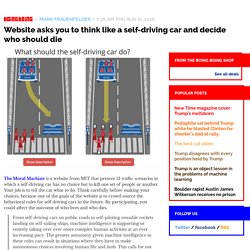
Your job is to tell the car what to do. Think carefully before making your choices, because one of the goals of the website is to crowd source the behavioral rules for self driving cars in the future. By participating, you could affect the outcome of who lives and who dies. From self-driving cars on public roads to self-piloting reusable rockets landing on self-sailing ships, machine intelligence is supporting or entirely taking over ever more complex human activities at an ever increasing pace.
The greater autonomy given machine intelligence in these roles can result in situations where they have to make autonomous choices involving human life and limb. Report this ad. Apple shows ambition to get into self-driving car race. Autonomous vehicles could cost America 5 million jobs. What should we do about it? Suddenly the era of driverless cars seems very near indeed.
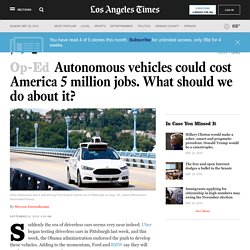
Uber began testing driverless cars in Pittsburgh last week, and this week, the Obama administration endorsed the push to develop these vehicles. Adding to the momentum, Ford and BMW say they will produce autonomous cars by 2021. Driverless cars will create some big winners — imagine how Uber’s and Lyft’s profits will jump when they can keep 100% of fares instead of letting drivers keep 70%. But they will produce some big losers too, notably the 5 million people nationwide — including 600,000 in California — who make their living driving taxis, buses, vans, trucks and e-hailing vehicles. That’s almost 3% of the workforce, according to Lawrence Katz, a labor economist at Harvard. Les premiers taxis sans chauffeur roulent à Singapour. Uber et Google en rêvaient, nuTonomy l’a fait.

Les premiers taxis sans chauffeur ont commencé à circuler jeudi 25 août, à Singapour, lors d’un essai dans une zone limitée, ce qui constitue une première mondiale et une avancée importante dans la course au transport de personnes par véhicule autonome. Les six taxis – des voitures électriques Renault Zoe et Mitsubishi i-MiEV – roulent dans un espace de quatre kilomètres carrés, avec des endroits désignés pour prendre et déposer des passagers. Dsrc petition pn comments fina 63171. Self-driving cars - Video. BizzGrid (@BizzGrid) CONNECTED VEHICLES - Welcome To bizzgrid. Plow. By Alister Wm Macintyre (Al Mac)
Object moved. Autonomous Vehicles Many people consider autonomous vehicles to be a significant part of the future of the automotive industry. As the technology for autonomous vehicles continues to develop, it may be necessary for state and municipal governments to address the potential impacts of these vehicles on the road. Sixteen states introduced legislation related to autonomous vehicles in 2015, up from 12 states in 2014, nine states and D.C. in 2013, and six states in 2012. Latest News In January 2016, U.S. Nevada was the first state to authorize the operation of autonomous vehicles in 2011. Florida’s legislation, passed in 2012, declared the legislative intent to encourage the safe development, testing and operation of motor vehicles with autonomous technology on public roads of the state and found that the state does not prohibit nor specifically regulate the testing or operation of autonomous technology in motor vehicles on public roads.
Additional Resources NCSL Resources State Resources. Autonomous Car Driving through heavy City Traffic. Autonomous Cars Influence Study. Autonomous Cars Influence Study (July 2014) Self-driving cars may not yet be on the dealer’s lot, but the market is rapidly developing into one driven by tech companies, as traditional automakers scramble to play catch-up. Google’s reveal of their self-built car rocketed their influence up 4x, while other tech players like Intel saw their own gains. Meanwhile, automotive giants like GM and Mercedes are stuck in neutral, as startups Uber and Zipcar are nipping at their heels.
Appinions’ study found Google to be the most influential company in the autonomous cars sector, a market which saw rapid fluctuations in conversation over the two month study period, steered largely by product announcements and demos. Intel claimed the number two spot in the “10 Most Influential Autonomous Cars Companies” ranking in the influence study, followed by carmakers GM, Mercedes Benz, Audi, and Nissan. Top Gear BMW that needs no driver. Potential obstacles. Potential Advantages. Major Automobile Manufacturers. Infographic. Autonomous Vehicle. Legislative and Regulatory Action. EN-V: Not your grandfather’s Chevy - Nightly. If you thought last week’s Spark EV announcement was a move toward urban density solutions, you would be correct, but Chevrolet has not finished downsizing its electric mobility offerings.
Also announced last week was the Chevrolet-badged second generation of the EN-V Concept. According to Chris Perry, vice president, global Chevrolet marketing and strategy, the bowtie insignia is significant for the EN-V – which is short for Electric Networked-Vehicle. “For 100 years, the Chevrolet brand has been focused on making advanced technology that improves customers’ lives accessible and affordable, and the Chevrolet EN-V will continue that tradition,” said Perry. “By 2030, more than 60 percent of the world’s 8 billion people will live in urban areas. The Chevrolet EN-V represents a possible solution for global customers living in markets where alternative transportation solutions are needed.” 2011-Concept-Chevrolet-EN-V-051. "Self Driving" Vehicles: Great Benefits, but Barriers to Widespread Adoption. RAND > Multimedia > "Self Driving" Vehicles: Great Benefits, but Barriers to Widespread Adoption About the Briefing Autonomous, or “self-driving” vehicle technology offers the possibility of significant benefits to social welfare—saving lives; reducing crashes; increasing mobility for the disabled; and ultimately improving land use.
Vehicular communication systems. Former GM R&D Head Predicts Driverless Cars By 2020. Looking into the tea leaves – that is, citing transportation and demographic trends – a former General Motors R&D head has said that by 2020, self-driving vehicles will be available. The 2020 vision for autonomous vehicles presented by Larry Burns at the University of Michigan Robotics Day could solve such issues as distracted driving and tailgating. It could also dovetail with calls for reliance on lighter – likely hybrid or all-electric – vehicles, and greater efficiency. A few years back, GM made the case for the Volt as a car for the future based on studies that average daily driving for three-quarters of Americans was under 40 miles per day. That, it said, was good enough to justify its “moon shot” experiment for the plug-in car. Looking ahead again, GM’s former head of R&D, according to Automotive News, told the Michigan audience about a soon-to-be world of driverless cars tracked by GPS with collision avoidance systems that are already well underway .
What do you think? Brad Ideas - Nightly. I often see the suggestion that as Robocars get better, eventually humans will be forbidden from driving, or strongly discouraged through taxes or high insurance charges. 10 Autonomous Driving Companies To Watch. Autonomous Vehicle Technology: How to Best Realize Its Social Benefits.